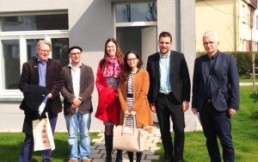The sky is the limit for Poland's air pollution crisis
28th April 2017, by Adrian Joyce, Renovate Europe Campaign Director

If a European police force dispatched scent-sensitive drones across the suburbs in a last ditch bid to prevent thousands of deaths, you might think a terror attack was imminent.
But the Polish police officers filmed last month surveilling residents in Zywiec were tailing a crime wave motivated by nothing more sinister than the desire to keep warm.
Its effects though are clear, or rather they are smoggy. For cheap wood, coal and waste burned indoors are contributing to a smog problem in the town that sometimes surpasses even Beijing's.
In Zakopane, Poland's top ski resort, fine dust concentrations are measured at densities greater than in New Delhi, creating lung-busting smogs, with all the attendant health hazards.
Across Poland, air pollution kills around 45,000 people every year, the legacy of a coal-dominated energy infrastructure and decades of poorly-built housing stretching back to the Soviet-era and beyond.
Seventy percent of the country's five million single-family households do not have adequate insulation, according to Poland's Institute of Environmental Economics.
This single-family demographic represents the poorer half of the population. To heat their buildings, many use the cheapest and least environmentally friendly materials and methods.
Substandard fuels such as brown coal and coal mine waste are incinerated en masse in obsolete solid fuel boilers with low efficiency and high emissions – not just of CO2, but particulate matter (PM2.5 and PM10) and carcinogenic substances such as benzo(a)pyrene.
An estimated 87% of Poland's benzo(a)pyrene emissions - and 52% of its PM10 releases – come from low stack emissions (sources with a height of less than 40m). Poland is currently facing a European court case over this issue.
In February, the development ministry promised to bring forward a programme for modernising Poland's single-family houses by the middle of the year.
This is welcome news, with the government due to hand in a national strategy for buildings renovations to the European commission this month.
Taken together, these two developments mark “a turning point,” says Anna Sokulska, a spokesperson for the Institute of Environmental Economics.
“They should be a part of a bigger and wider strategy,” she said, “but some people in government treat this only as something they are being forced to do by the EU. They don't treat it as something meaningful.”
This is a tragedy. Experience from the Czech Republic and Germany shows that a well-developed, ambitious program for buildings renovation can bring many new jobs, higher budgetary incomes, better health and a revival of the construction and insulation sectors.
Poland currently spends nothing on improving the energy efficiency of single-family buildings, compared to €1.50 in Germany, €2.50 in the Czech Republic and €5.50 in Slovakia.
It is time that Poland turned the page on antiquated polluting buildings that warm the planet but leave its own citizens huddling in cold and toxic misery. This is a problem that drones cannot solve on their own.
END
Learn more about Renovate Europe's National Partner in Poland and their work on Energy Renovation in Poland: Efficient Poland
Energy Renovation: The double-brainer solution to Europe's indoor air quality problem
28th April 2017, by Adrian Joyce, Renovate Europe Campaign Director

Energy renovations are often labelled a “no brainer” but on the basis of new research, it might be more accurate to call them a double-brainer.
In one double-blind study published last year, the cognitive performances of workers in an enhanced green building environment were found to be 101% higher than in conventional buildings.
Crisis response scores were 131% better, strategy scores 288% greater and information usage scores a staggering 299% higher for employees not exposed to the sort of elevated levels of CO2 and volatile organic compounds (VOCs) typically found in urban building environments.
More modest improvements were confirmed by another study in 2016, which scored a 25% lift in cognitive functioning tests, 30% fewer 'sick building' symptoms and better sleeping patterns, among employees who worked in green buildings.
We spend the vast majority of our lives – up to 90% of our time - indoors and the same percentage of business costs are toted up within buildings. Yet we seem to be surprisinngly indifferent to the environment in which we thrive.
Straightforward improvements such as improved ventilation, lighting and heating control can have a dramatic effect on the quality of our lives - at work and at home.
As you read this, you may well be breathing in one or more of a dizzying array of pollutants – carbon monoxide, radon, ozone, particulates, microbial contaminants, volatile organic compounds, mould – which each carry their own dizzying array of health symptoms.
Prolonged indoor exposure to ozone can cause decreased lung function and respiratory pain. Excess particulates levels in your living room may trigger airway inflammation, or subtle changes in the markers of cardiovascular disease. With mould, asthma-like symptoms such as chronic wheezing are not uncommon.
The green building alternative still seems mythic to many people, a unicorn logged by wonks in policy briefings. But in an anonymous Brussels suburb last week, a delegation of EU diplomats visited just such a legend; a refurbished model home of the future – built in the 1920's – to find out more.
The Velux house on Rue Jean Lagey looks unexceptional from the outside, but behind its thick white door lies a bright, airy and hyper-modern interior, designed by an Antwerp architect with a built-on extension at the back.
The home central heating is a thing of wonder. Two solar panels (one on a grass covered roof) provide a third of the domestic power. Triple glazed windows keep the warmth in, while a heart-shaped 'health box' ventilation system pumps stale air out - and fresh air in.
This can all be done on automatic settings. Sensors control room temperature, humidity and carbon dioxide levels, while wall-size windows, sun tunnels and remote controlled shades all let the sun shine in.
“Daylight and fresh air are essential to our wellbeing,” said Jernej Vernik, the Velux EU affairs manager leading the tour. “You can actually feel the air moving up and the daylight coming in the spiral staircase and out of the window.”
Mayors, ministers, civil servants and school students have dropped in on the “active house” demo home, one of planned renovated properties run by the 'Le Foyer Anderlechtois' housing association.
But that represents just 0.01% of the association's stock, and Le Foyer Anderlechtois is in the green buildings vanguard. Could the scheme really catch on?
“I think it’s a universal concept,” one of the diplomats said. “I'm very, very glad we had the chance to see it. We have to educate people about this, but it shouldn't be that difficult. It is mostly a question of money.”
The renovation is “legally” limited €1,200 per sq metre which, spread over the average house's 80m2 in the neighborhood, would mean a total cost of €96,000 for each renovation.
That might sound a lot but given the savings on energy bills and increase in property value the scheme brings – not to mention the health and climate benefits as well as the fact that the house was considered ‘inhabitable’ before renovation – funding such schemes should be a double-brainer for Europe's purse-string holders.
END
Download the Renovate Europe infographic "Why is Energy Renovation the Long-term Solution to improved Health?"
France: Where energy efficiency tops the polls
France: Where energy efficiency tops the polls

20th April 2017, by Adrian Joyce, Renovate Europe Campaign Director
Whoever is elected in the French elections, it seems that the building renovations industry will win.
Energy renovation programmes have been a substantial feature in the manifestos of all leading presidential candidates - and in the presidential TV debates.
That means French voters can choose from a range of often detailed energy efficiency programmes, in the first round of polling on April 23. But how did it happen?
“The subject emerged in this campaign because we built a specific alliance to make it emerge,” says Danyel Dubreuil, a spokesperson for the Renovons! (Let’s Renovate!) campaign.
A popular front of housing associations, green groups, private companies, France's biggest trades union and even Catholic networks helped transform state support for energy renovations into a consensus issue, he contends.
Around one third of housing in France – 7m houses or apartments – is poorly insulated, and energy poverty is a resonant issue with working-class voters coveted by both the left and right.
So who is top of the energy renovation pops?
According to Renovons!, which has prepared a handy guide to the positions of the leading candidates, the number one spot goes to Benoît Hamon, the socialist candidate who has promised a breathtaking €100bn “urban and thermal” renovation plan, involving a €6bn a year set aside to refurbish public buildings and improve energy storage.
This would guarantee that the poorest third of householders spend no more than 10% of their annual income on energy, Hamon says.
Close on his tail is Jean-Luc Mélenchon, who has pledged to insulate 700,000 housing units a year, imposing new energy renovation obligations - and associations - while establishing a one-stop shop for financing, needs assessments and coordination of refurbishments.
The front-runner in many polls, Emmanuel Macron, offers a less ambitious but better-costed €4bn programme to renovate public buildings. If elected, he has vowed to scrap a one year delay to new applications for France's energy transition tax credit scheme, introduce free efficiency audits, and set up a target to renovate half of the poorest and smallest dwellings by 2022.
On the right of the political spectrum, François Fillon promises to continue the current government's renovation assistance programmes, to “amplify” energy saving policies, and to “generalise” energy assessments of buildings.
Even the far-right Marine Le Pen has a minor manifesto pledge (number 132) to make insulation a “budgetary priority” in public procurement policy.
One key underlying reason for the increased interest in renovations is France's energy transition law, which sets a target for renovating all buildings with 'F' and 'G' energy classes by 2025.
But Dubreuil argues that energy renovations are also becoming this election's environmental touchstone because they are a potential vote-winner with no polarising or conflictual undertones.
“It is a good thing to see that the political consensus is now so large and powerful,” he said. “It was not this clear before and I think it is a very good result of our campaign. The question is: how will it be transformed into a concrete and complete plan in the next five years?”
As manifesto-drafters get to work in the UK and Germany, another question might be: How long it will take for this French election lesson to spread across Europe?
END
Learn more about Renovate Europe's National Supporting Partner in France, and about the Renovons Campaign.
Op-ed: Energy poverty: A blight on the EU (Euractiv)
Published by Euractiv on: 6 April 2017 | For something that blights the lives of between 50 and 125 million European citizens it is strange to discover that there is no EU-wide definition of ‘energy poverty’, writes Adrian Joyce.
Making it Real - Site to Renovated House with Energy Attachés
The Renovate Europe office organised a site visit for Energy Attachés to the Renovactive house in Anderlecht on Wednesday 29th March.
The RenovActive house is a demonstration project of VELUX, a partner of the Renovate Europe Campaign. A typical 1920s house in the Brussels suburb was fully renovated with the double aim of significantly reducing energy consumption but also of improving the daylight and fresh air for future inhabitants. The fact that the house is part of a social housing estate meant that costs had to be kept within a restricted budget, in cooperation with the local social housing authority, and that the project has very strong replicability potential to neighbouring houses. This is an excellent example of how to maximise the untapped energy efficiency potential of the EU building stock for the benefit of EU citizens and families, in terms not only of reduced energy bills but also improved health and comfort.
Relevant documents:
- Renovate Europe Presentation: How to reduce the energy demand of the building stock by 80% - the example of the RenovActive House
- Velux Presentation of Renovactive: a healthy and affordable concept
- Legislative Reviews of the EPBD and EED: How to make Renovate Europe's NZEB vision a reality by 2050
- Renovate Europe Briefing 1/2017 about Energy Poverty
- Renovate Europe one-pager: Why is Energy Renovation the Long-term Solution to Improved Health?
- Renovate Europe one-pager: Why is a thriving Energy Renovation Market essential to drive the EU Economy?
More about project: https://renovactive.velux.be/fr/la-maison/architecture/
Interview about the Dutch National Elections 2017
Interview about the Dutch National Elections 2017

Interview with the Renovate Europe Dutch National Partner - the National Renovation Platform
How did energy renovation feature in the Dutch national elections?
Strangely enough there was all but no attention towards energy-efficiency and climate in the weeks and days before the elections. Could it be, that the political leaders thought, that that was of no interest to the Dutch voters? Or could it be that they wanted to avoid the subject, due to the huge financial impact it's going to have in the coming years? The latter seems to be more probable, since so many people in the Netherlands have deep concerns about climate and energy in the future. Especially young people have taken a considerable interest in the matter.
How did NRP contribute to the debate?
NRP Spaar het Klimaat focused on the political leaders and worked to organise two political debates to raise attention around energy efficiency in buildings among candidates for the new parliament. It also focused on raising support for candidates who declared their support to stop energy waste in buildings. The campaign website was launched and approximately 100 000 followers on twitter and facebook were informed. 8 candidates of 6 political parties (CDA, PvdA, D66, Greenleft, ChristenUnion) signed the declaration.
On 25-2-2017 we hosted the first political debate, in cooperation with football club SC Heerenveen with 7 candidates for the Parliament: VVD, PvdA, CDA, D66, Greenleft, ChristenUnion and 50Plus. Following the success of this debate we scheduled the second debate on 12-3-2017 in Amsterdam in cooperation with the Amsterdam Arena. Due to the fact that a debate on this issue was clearly, in the end, not in the interest of all political parties, it was called off a few days before the debate by withdrawal of one of the leaders. An argument that was used at that moment, was that the issue of climate change was part of the last public debate on television.
How do you think the new government will tackle energy renovation?
Traditionally the Association of Employers in the Netherlands contribute publicly and with great influence on national political matters. They have chosen to demand a "green agenda" for the next government. In their motivation there are lots of words about the positive economic impact of such a choice and especially where building and renovation of real estate is at stake. It's likely that this will have an impact on the political agenda.
Although almost absent in the Dutch political debate, in the written and agreed programs of the respective political parties, energy and sustainability, are important chapters with detailed plans and goals. That's why I anticipate a thorough discussion on the "green subjects" in the formation of a new government, now the elections are over. That's unavoidable, because all parties seem to take the Kyoto-Paris obligations about the climate very seriously.
END










